
The S-Bahn is a hybrid urban-suburban rail system serving a metropolitan region predominantly in German-speaking countries. Some of the larger S-Bahn systems provide service similar to rapid transit systems, while smaller ones often resemble commuter or even regional rail systems. The name S-Bahn derives from Schnellbahn, Stadtbahn or Stadtschnellbahn.

The Hamburg S-Bahn is a rapid transit railway system in the Hamburg Metropolitan Region. Together, the S-Bahn, the Hamburg U-Bahn, the AKN railway and the regional railway form the backbone of railway public transport in the city and the surrounding area. The network has operated since 1907 as a commuter rail system, under the direction of the state railway, and is a member of the Hamburger Verkehrsverbund. There are four lines, serving 68 stations, on 147 kilometres (91 mi) of route. On an average working day the S-Bahn transports about 590,000 passengers; in 2010 about 221 million people used the S-Bahn.

The Hamburg U-Bahn is a rapid transit system serving the cities of Hamburg, Norderstedt, and Ahrensburg in Germany. Although referred to by the term U-Bahn, most of the system's track length is above ground. The network is interconnected with the city's S-Bahn system, which also has underground sections. It is operated by Hamburger Hochbahn within the Hamburger Verkehrsverbund (HVV). It was opened in February 1912, and comprises four lines serving 93 stations, with a route length of 106.4 kilometres (66.1 mi) in 2019.
The city of Hamburg in Germany is made up of seven boroughs and subdivided into 104 quarters. Most of the quarters were former independent settlements. The areal organisation is regulated by the constitution of Hamburg and several laws. The subdivision into boroughs and quarters was last modified in March 2008.

Poppenbüttel railway station is on the Alster Valley line and is served by the rapid transit trains of the Hamburg S-Bahn.

Barmbek is a railway station and transport hub in Hamburg, Germany, for the underground railway (U-Bahn) system and the suburban railway (S-Bahn) system. The station is located in the district of Barmbek-Nord, Germany. Barmbek-Nord is part of the borough of Hamburg-Nord.

AKN Eisenbahn GmbH operates railway lines, commuter trains and freight trains in Hamburg and Schleswig-Holstein. Its headquarters is in Kaltenkirchen. It is a member of the Hamburger Verkehrsverbund (HVV), which organises public transport in and around Hamburg.

Ohlsdorf is a railway station in Hamburg, Germany, located at the junction of the Hamburg-Altona link line with the Alster Valley line and the Hamburg Airport line in Ohlsdorf, Hamburg near the Ohlsdorf Cemetery.

The DBAG Class 474/874 is a three-car electric multiple unit train for the Hamburg S-Bahn. The class 474 were built to replace the nearly-60-year-old class 471 trains. Some units have a pantograph (474.3) to service the 2007 opened line to Stade on an overhead catenary track.
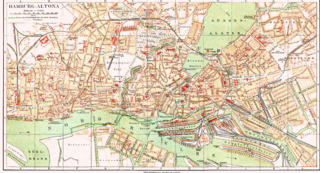
The Hamburg-Altona link line is a railway line in Hamburg, Germany. Nowadays, it connects the lines from the north and northwest of Hamburg and Altona station with Hamburg Hauptbahnhof and the lines to the southwest, south and east. Initially designed as a freight line only, it is now one of the busiest lines in Germany. It includes the suburban tracks of the Hamburg Stadtbahn, originally the core of the Hamburg S-Bahn.

The Altona–Blankenese railway is a railway line to the west of Hamburg. It starts at the Altona station and runs through Othmarschen to Blankenese station. This section of line was opened in 1867. 16 years later the line was extended to Wedel. It is now used by lines S1 and S11 of the Hamburg S-Bahn and was part of the first electrified suburban railway in Germany.
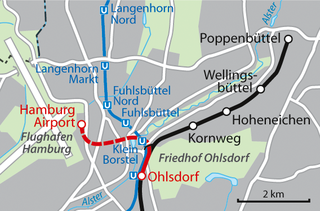
The Hamburg Airport S-Bahn line is a nearly three-kilometre long railway line used by the Hamburg S-Bahn. It was opened on 11 December 2008.

The Harburg S-Bahn line is a railway line in southern Hamburg, Germany. It starts at Hamburg Hauptbahnhof and runs via Harburg to Stade. It mostly runs parallel with the line to Hanover and the Lower Elbe line and is now part of the Hamburg S-Bahn lines S3 and S31.
The Alster Northern Railway or ANB was a non-electrified, single-tracked branch line in northern Germany. It linked the stations of Ochsenzoll in Hamburg-Langenhorn with Ulzburg Süd in the district of Segeberg in Schleswig-Holstein.

The Hamburg freight rail bypass is a railway line in the German city of Hamburg. It runs from Hamburg-Eidelstedt via Hamburg-Rothenburgsort to Hamburg-Harburg and connects the long-distance railways approaching Hamburg, bypassing the link line and the railway junctions on the approaches to Hamburg-Altona station and Hamburg Hauptbahnhof. The line is mainly used for rail freight.

The Hamburg-Altona–Neumünster railway is the original line of the AKN Eisenbahn (railway) in the German states of Hamburg and Schleswig-Holstein. Today, passenger services on the 64.5 km-long Hamburg Eidelstedt–Neumünster section are operated by AKN.
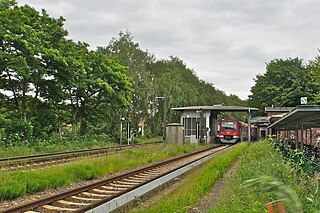
Sülldorf railway station in Hamburg, Germany, is located on the extended Altona-Blankenese line and is served by the trains of the Hamburg S-Bahn.
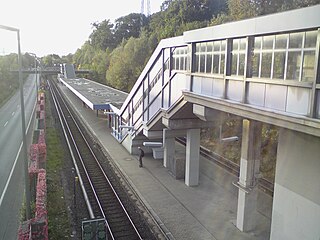
Rissen railway station in Hamburg, Germany, is located on the extended Altona-Blankenese line and is served by the trains of the Hamburg S-Bahn.
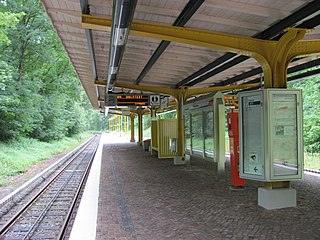
Buckhorn is a station in Volksdorf on the Hamburg U-Bahn line U1. It is located on the Ohlstedt branch of the line.
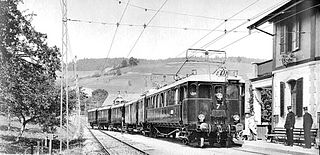
The Burgdorf–Thun railway is a railway line in Switzerland, which was built by the Burgdorf-Thun-Bahn. The line from Burgdorf via Konolfingen to Thun was opened by the company in 1899 as the first electrified mainline railway in Europe. It is now part of BLS AG.





















